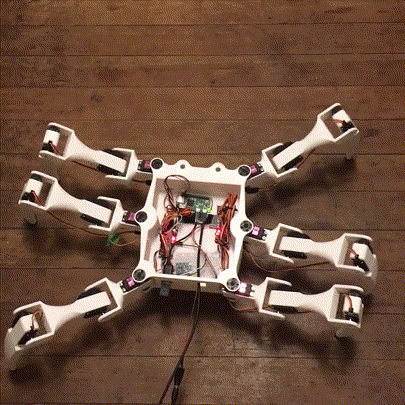hexapod

This project began in December 2019 after I had finished my senior capstone project. I wanted to get more hands on engineering experience and teach myself new software skills. The idea for a hexapod came after seeing similar robots created by students the previous semester. I wanted to improve my knowledge of Python, CAD (specifically SolidWorks), Linux, and general robotics.
I started by planning out the project steps. I thought I would first prototype the hexapod leg and use a controller to control the motion on a 2D plane. Next I would design, print, and build the full hexapod. Then I would begin coding the logic to control the 18 servo motors to get the robot moving. I wanted to complete all of this before the end of the semester, which was quite ambitious.
I began by learning how to set up and use a headless Raspberry Pi. I had never used a Raspberry Pi or similar single board computer before and I wanted to challenge myself by using it without a monitor to farmiliarize myself with the Linux command line and SSH. I found some Python code for communicating with a Steam Controller (The only controller I had available) on the RPi operating system that I used to control the motion of the hexapod test leg. These two steps proved more challenging than I anticipated, and I spent much of the first month of this project adapting the Python code for my specific use. Once I returned to campus, I immediately began to CAD the hexapod. This took me about two weeks, working only when I had free time. Now the most boring and time-consuming step: 3D printing everything. I wanted my hexapod to be big, which in retrospect was not the best choice as I had to wait several weeks for all the parts to be printed. Once all the parts were finally printed, I began assembly. While I was assembling the robot, I also began to work on the code. Through research and talking with professors and fellow students, I discovered inverse kinematics was necessary for this project. After many hours of research on computation of inverse kinematics using numerical methods, I decided to take an analytical approach which ended up being quite simple.
With the robot built and the inverse kinematics solved, finally it was time to sequence the movement of the legs. The motion of each leg was hard-coded where the tip of each leg would follow a Bezier curve path in order to prevent slipping. The legs would then be sequenced to produce a specific gait. There are three main gaits used for hexapod motion, sometimes seen as the tripod, ripple, and wave gaits. I decided to focus on the most common gait, the tripod gait, but also to build my code in such a way that it would easily adapt to other gaits. Unfortunately, at this point in the project, all students were sent home due to COVID-19 and I was forced to finish the project at home with significant lack of tools. This distruption made it much more difficult to work on the project, but I was determined to get the robot walking with at least the tripod gait, and eventually, after much trial and error, the robot was on the move!

There were two primary issues with this iteration of the robot: the Python code was not running fast enough to give good control of the robot, and the complexity of the electronics. To address these issues, I plan on using a Teensy microcontroller on version 2 and a custom PCB and different motors (either better servo motors or dc motors) to consolidate the electronics. I look forward to reviving the project at some point and I have already designed version 2 of the robot with a full enclosure and two robot arms. With no current access to 3D printers and other competing priorities, this project is on hold for now.